Analyzing External Crisis Factors Affecting General Mills Business
VerifiedAdded on 2023/04/07
|7
|902
|425
Report
AI Summary
This report analyzes the external factors affecting General Mills' business operations, focusing on economic, political, demographic, social, competitive, and technological aspects. It identifies both positive and negative implications of these factors, such as decreased consumer confidence, import restrictions, demographic shifts, increasing competition from US retailers, and technological advancements. The report recommends strategies to improve product quality and customer service, adapt to import restrictions, cater to health-conscious consumers, refine target marketing, and leverage technological advancements. It concludes by emphasizing the importance of adapting to external factors and providing an action plan to effectively manage these challenges.

Running head: EXTERNAL MANAGEMENT CRISIS
EXTERNAL MANAGEMENT CRISIS
Student’s Name
University Name
Author note
EXTERNAL MANAGEMENT CRISIS
Student’s Name
University Name
Author note
Paraphrase This Document
Need a fresh take? Get an instant paraphrase of this document with our AI Paraphraser

1
EXTERNAL MANAGEMENT CRISIS
Executive summary
The purpose of this report is to analyze the eternal factor in an organization which affects
the operations of the organization. It determines the factors affecting business of General Mill. It
analyses the factors of increase and competition and advancement in technology and determines
the positive and negative outcomes of the factors affecting the business. Further it provides
recommendations to take advantage of these factors and the recommendations to overcome the
external factors.
EXTERNAL MANAGEMENT CRISIS
Executive summary
The purpose of this report is to analyze the eternal factor in an organization which affects
the operations of the organization. It determines the factors affecting business of General Mill. It
analyses the factors of increase and competition and advancement in technology and determines
the positive and negative outcomes of the factors affecting the business. Further it provides
recommendations to take advantage of these factors and the recommendations to overcome the
external factors.
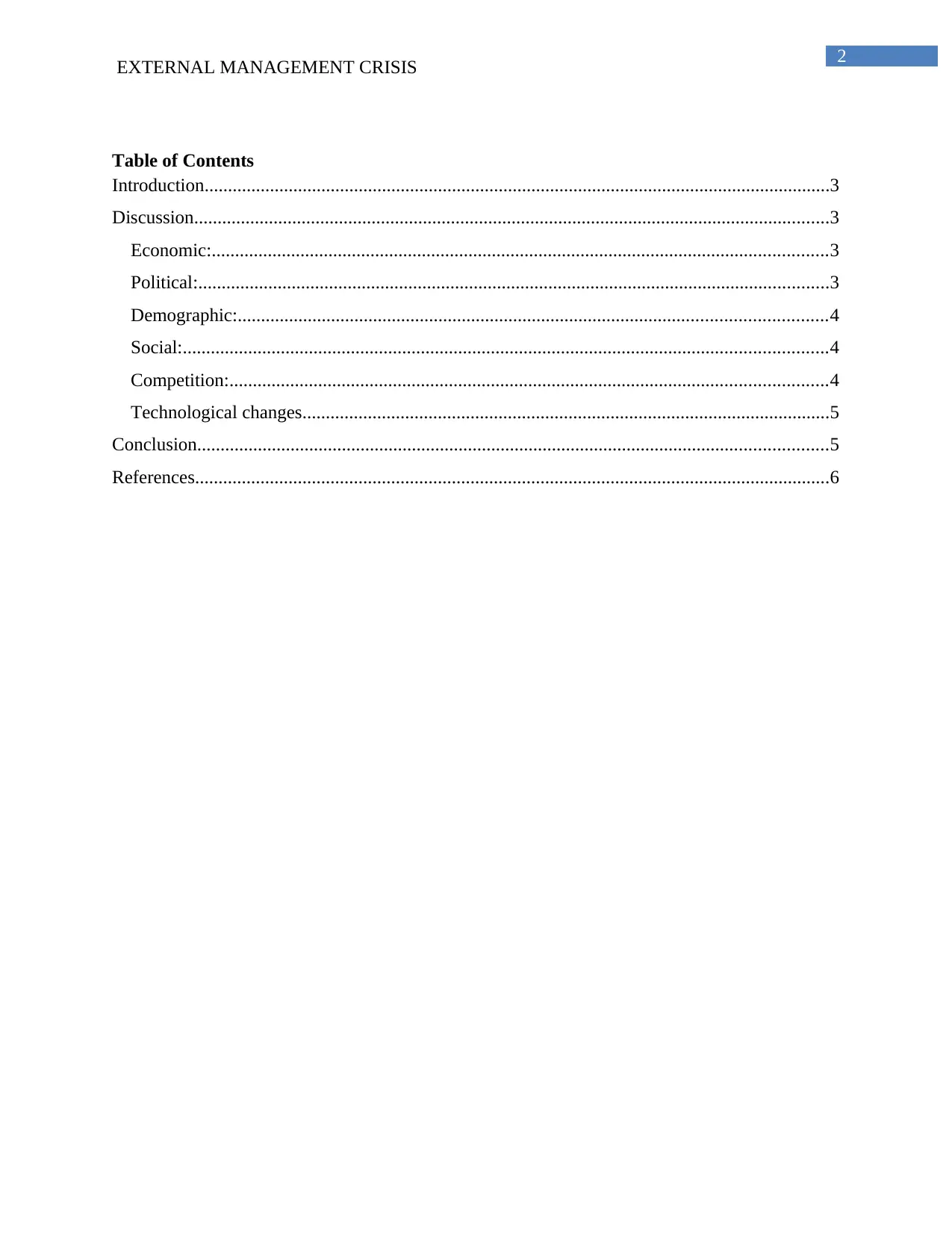
2
EXTERNAL MANAGEMENT CRISIS
Table of Contents
Introduction......................................................................................................................................3
Discussion........................................................................................................................................3
Economic:....................................................................................................................................3
Political:.......................................................................................................................................3
Demographic:..............................................................................................................................4
Social:..........................................................................................................................................4
Competition:................................................................................................................................4
Technological changes.................................................................................................................5
Conclusion.......................................................................................................................................5
References........................................................................................................................................6
EXTERNAL MANAGEMENT CRISIS
Table of Contents
Introduction......................................................................................................................................3
Discussion........................................................................................................................................3
Economic:....................................................................................................................................3
Political:.......................................................................................................................................3
Demographic:..............................................................................................................................4
Social:..........................................................................................................................................4
Competition:................................................................................................................................4
Technological changes.................................................................................................................5
Conclusion.......................................................................................................................................5
References........................................................................................................................................6
⊘ This is a preview!⊘
Do you want full access?
Subscribe today to unlock all pages.

Trusted by 1+ million students worldwide
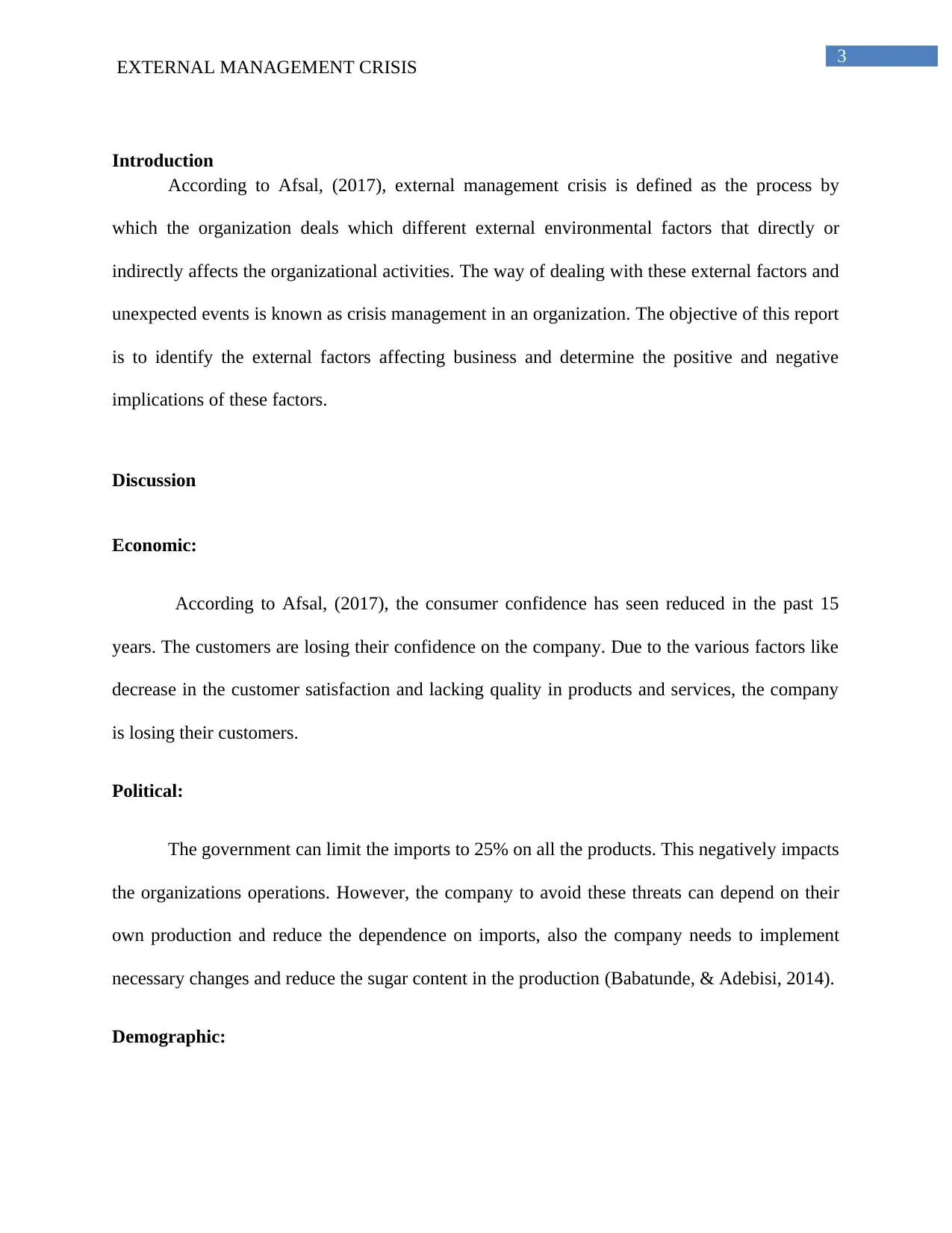
3
EXTERNAL MANAGEMENT CRISIS
Introduction
According to Afsal, (2017), external management crisis is defined as the process by
which the organization deals which different external environmental factors that directly or
indirectly affects the organizational activities. The way of dealing with these external factors and
unexpected events is known as crisis management in an organization. The objective of this report
is to identify the external factors affecting business and determine the positive and negative
implications of these factors.
Discussion
Economic:
According to Afsal, (2017), the consumer confidence has seen reduced in the past 15
years. The customers are losing their confidence on the company. Due to the various factors like
decrease in the customer satisfaction and lacking quality in products and services, the company
is losing their customers.
Political:
The government can limit the imports to 25% on all the products. This negatively impacts
the organizations operations. However, the company to avoid these threats can depend on their
own production and reduce the dependence on imports, also the company needs to implement
necessary changes and reduce the sugar content in the production (Babatunde, & Adebisi, 2014).
Demographic:
EXTERNAL MANAGEMENT CRISIS
Introduction
According to Afsal, (2017), external management crisis is defined as the process by
which the organization deals which different external environmental factors that directly or
indirectly affects the organizational activities. The way of dealing with these external factors and
unexpected events is known as crisis management in an organization. The objective of this report
is to identify the external factors affecting business and determine the positive and negative
implications of these factors.
Discussion
Economic:
According to Afsal, (2017), the consumer confidence has seen reduced in the past 15
years. The customers are losing their confidence on the company. Due to the various factors like
decrease in the customer satisfaction and lacking quality in products and services, the company
is losing their customers.
Political:
The government can limit the imports to 25% on all the products. This negatively impacts
the organizations operations. However, the company to avoid these threats can depend on their
own production and reduce the dependence on imports, also the company needs to implement
necessary changes and reduce the sugar content in the production (Babatunde, & Adebisi, 2014).
Demographic:
Paraphrase This Document
Need a fresh take? Get an instant paraphrase of this document with our AI Paraphraser
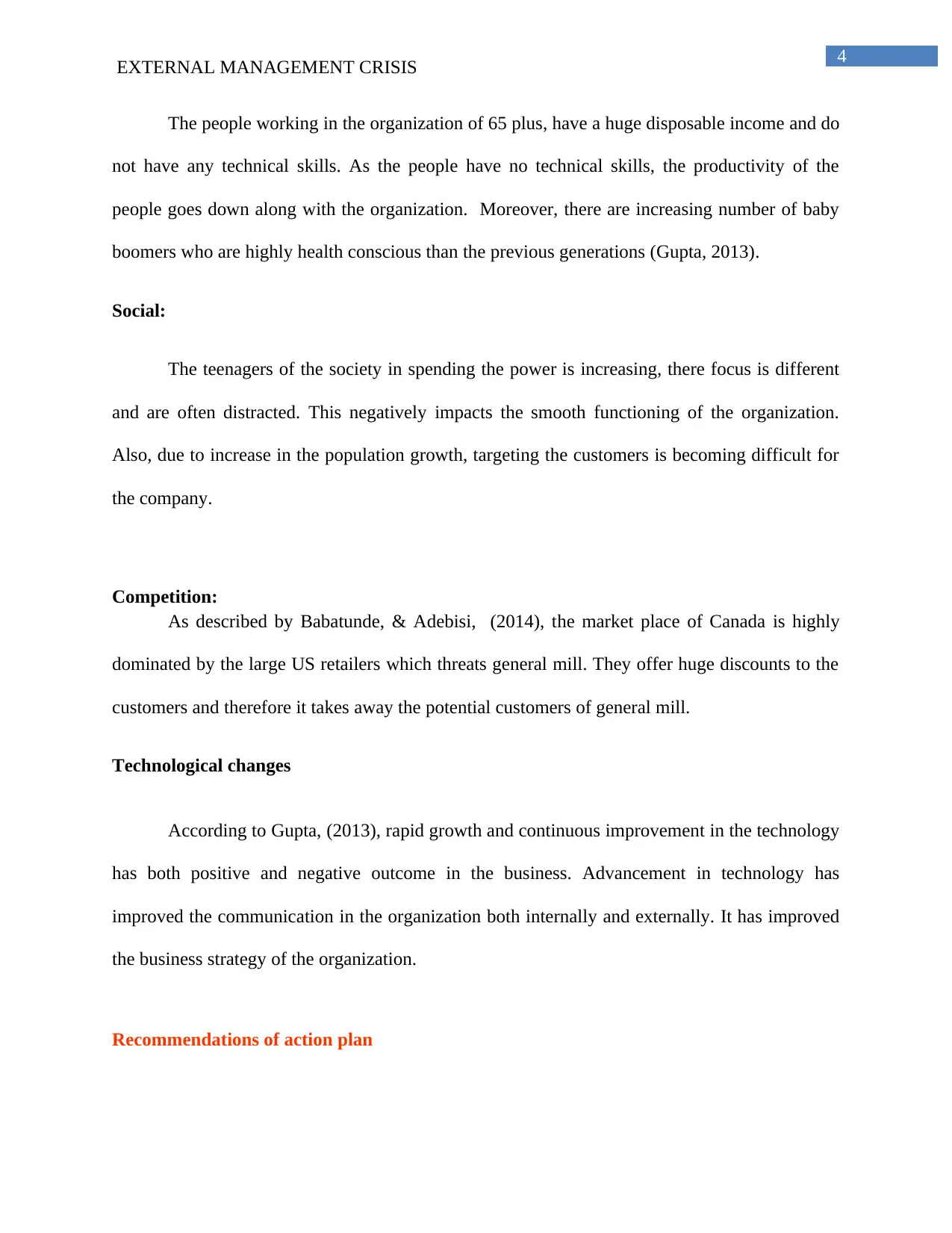
4
EXTERNAL MANAGEMENT CRISIS
The people working in the organization of 65 plus, have a huge disposable income and do
not have any technical skills. As the people have no technical skills, the productivity of the
people goes down along with the organization. Moreover, there are increasing number of baby
boomers who are highly health conscious than the previous generations (Gupta, 2013).
Social:
The teenagers of the society in spending the power is increasing, there focus is different
and are often distracted. This negatively impacts the smooth functioning of the organization.
Also, due to increase in the population growth, targeting the customers is becoming difficult for
the company.
Competition:
As described by Babatunde, & Adebisi, (2014), the market place of Canada is highly
dominated by the large US retailers which threats general mill. They offer huge discounts to the
customers and therefore it takes away the potential customers of general mill.
Technological changes
According to Gupta, (2013), rapid growth and continuous improvement in the technology
has both positive and negative outcome in the business. Advancement in technology has
improved the communication in the organization both internally and externally. It has improved
the business strategy of the organization.
Recommendations of action plan
EXTERNAL MANAGEMENT CRISIS
The people working in the organization of 65 plus, have a huge disposable income and do
not have any technical skills. As the people have no technical skills, the productivity of the
people goes down along with the organization. Moreover, there are increasing number of baby
boomers who are highly health conscious than the previous generations (Gupta, 2013).
Social:
The teenagers of the society in spending the power is increasing, there focus is different
and are often distracted. This negatively impacts the smooth functioning of the organization.
Also, due to increase in the population growth, targeting the customers is becoming difficult for
the company.
Competition:
As described by Babatunde, & Adebisi, (2014), the market place of Canada is highly
dominated by the large US retailers which threats general mill. They offer huge discounts to the
customers and therefore it takes away the potential customers of general mill.
Technological changes
According to Gupta, (2013), rapid growth and continuous improvement in the technology
has both positive and negative outcome in the business. Advancement in technology has
improved the communication in the organization both internally and externally. It has improved
the business strategy of the organization.
Recommendations of action plan
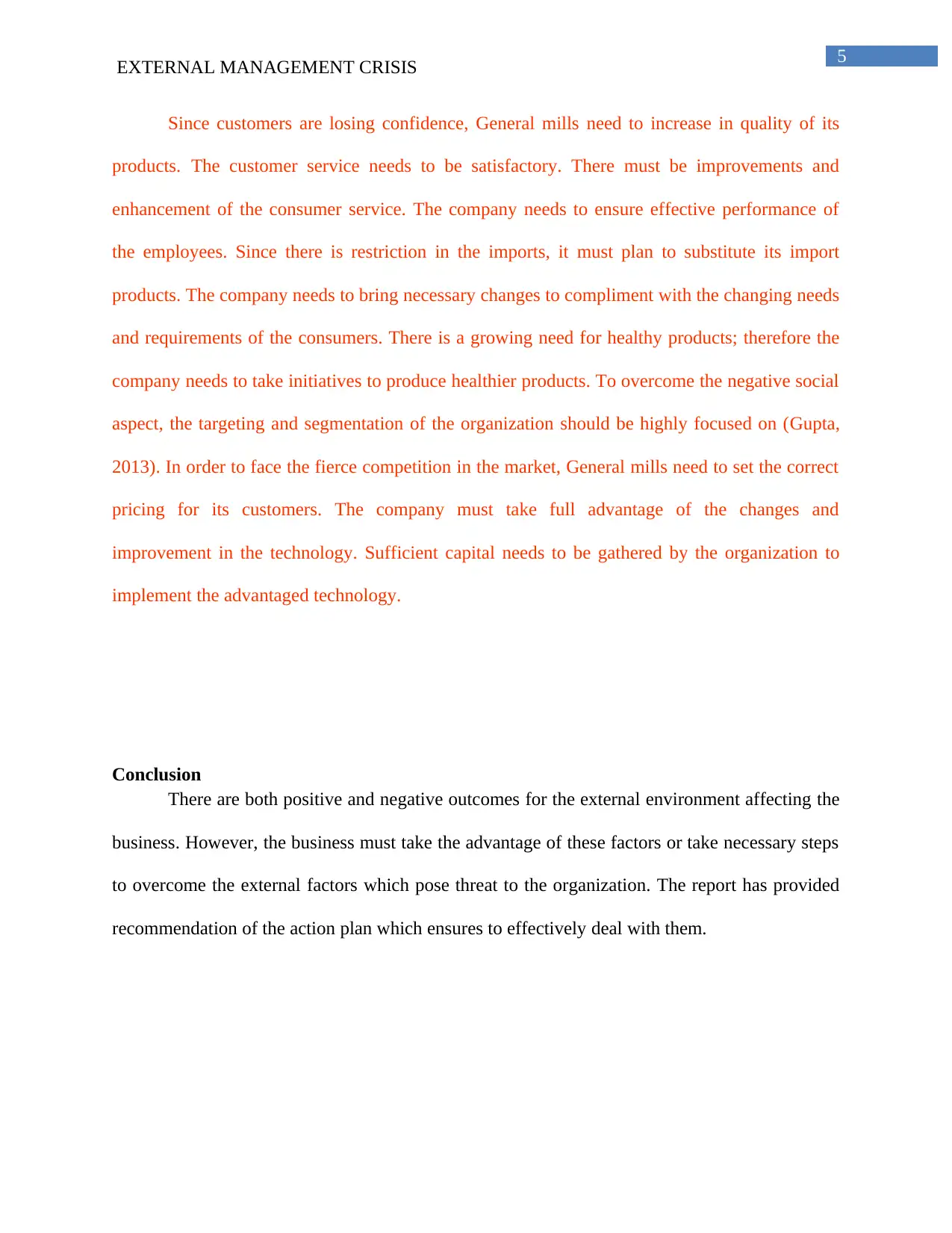
5
EXTERNAL MANAGEMENT CRISIS
Since customers are losing confidence, General mills need to increase in quality of its
products. The customer service needs to be satisfactory. There must be improvements and
enhancement of the consumer service. The company needs to ensure effective performance of
the employees. Since there is restriction in the imports, it must plan to substitute its import
products. The company needs to bring necessary changes to compliment with the changing needs
and requirements of the consumers. There is a growing need for healthy products; therefore the
company needs to take initiatives to produce healthier products. To overcome the negative social
aspect, the targeting and segmentation of the organization should be highly focused on (Gupta,
2013). In order to face the fierce competition in the market, General mills need to set the correct
pricing for its customers. The company must take full advantage of the changes and
improvement in the technology. Sufficient capital needs to be gathered by the organization to
implement the advantaged technology.
Conclusion
There are both positive and negative outcomes for the external environment affecting the
business. However, the business must take the advantage of these factors or take necessary steps
to overcome the external factors which pose threat to the organization. The report has provided
recommendation of the action plan which ensures to effectively deal with them.
EXTERNAL MANAGEMENT CRISIS
Since customers are losing confidence, General mills need to increase in quality of its
products. The customer service needs to be satisfactory. There must be improvements and
enhancement of the consumer service. The company needs to ensure effective performance of
the employees. Since there is restriction in the imports, it must plan to substitute its import
products. The company needs to bring necessary changes to compliment with the changing needs
and requirements of the consumers. There is a growing need for healthy products; therefore the
company needs to take initiatives to produce healthier products. To overcome the negative social
aspect, the targeting and segmentation of the organization should be highly focused on (Gupta,
2013). In order to face the fierce competition in the market, General mills need to set the correct
pricing for its customers. The company must take full advantage of the changes and
improvement in the technology. Sufficient capital needs to be gathered by the organization to
implement the advantaged technology.
Conclusion
There are both positive and negative outcomes for the external environment affecting the
business. However, the business must take the advantage of these factors or take necessary steps
to overcome the external factors which pose threat to the organization. The report has provided
recommendation of the action plan which ensures to effectively deal with them.
⊘ This is a preview!⊘
Do you want full access?
Subscribe today to unlock all pages.

Trusted by 1+ million students worldwide
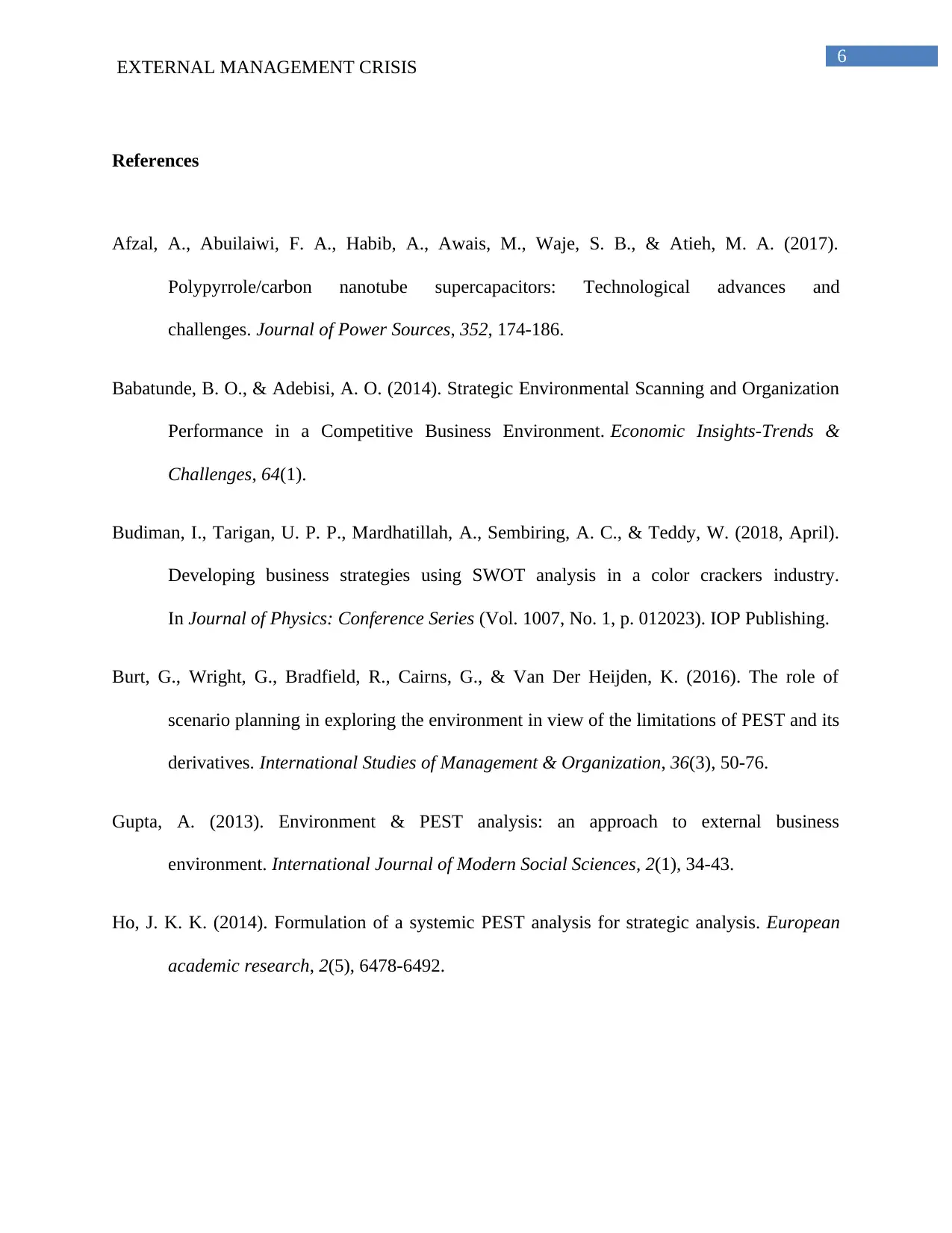
6
EXTERNAL MANAGEMENT CRISIS
References
Afzal, A., Abuilaiwi, F. A., Habib, A., Awais, M., Waje, S. B., & Atieh, M. A. (2017).
Polypyrrole/carbon nanotube supercapacitors: Technological advances and
challenges. Journal of Power Sources, 352, 174-186.
Babatunde, B. O., & Adebisi, A. O. (2014). Strategic Environmental Scanning and Organization
Performance in a Competitive Business Environment. Economic Insights-Trends &
Challenges, 64(1).
Budiman, I., Tarigan, U. P. P., Mardhatillah, A., Sembiring, A. C., & Teddy, W. (2018, April).
Developing business strategies using SWOT analysis in a color crackers industry.
In Journal of Physics: Conference Series (Vol. 1007, No. 1, p. 012023). IOP Publishing.
Burt, G., Wright, G., Bradfield, R., Cairns, G., & Van Der Heijden, K. (2016). The role of
scenario planning in exploring the environment in view of the limitations of PEST and its
derivatives. International Studies of Management & Organization, 36(3), 50-76.
Gupta, A. (2013). Environment & PEST analysis: an approach to external business
environment. International Journal of Modern Social Sciences, 2(1), 34-43.
Ho, J. K. K. (2014). Formulation of a systemic PEST analysis for strategic analysis. European
academic research, 2(5), 6478-6492.
EXTERNAL MANAGEMENT CRISIS
References
Afzal, A., Abuilaiwi, F. A., Habib, A., Awais, M., Waje, S. B., & Atieh, M. A. (2017).
Polypyrrole/carbon nanotube supercapacitors: Technological advances and
challenges. Journal of Power Sources, 352, 174-186.
Babatunde, B. O., & Adebisi, A. O. (2014). Strategic Environmental Scanning and Organization
Performance in a Competitive Business Environment. Economic Insights-Trends &
Challenges, 64(1).
Budiman, I., Tarigan, U. P. P., Mardhatillah, A., Sembiring, A. C., & Teddy, W. (2018, April).
Developing business strategies using SWOT analysis in a color crackers industry.
In Journal of Physics: Conference Series (Vol. 1007, No. 1, p. 012023). IOP Publishing.
Burt, G., Wright, G., Bradfield, R., Cairns, G., & Van Der Heijden, K. (2016). The role of
scenario planning in exploring the environment in view of the limitations of PEST and its
derivatives. International Studies of Management & Organization, 36(3), 50-76.
Gupta, A. (2013). Environment & PEST analysis: an approach to external business
environment. International Journal of Modern Social Sciences, 2(1), 34-43.
Ho, J. K. K. (2014). Formulation of a systemic PEST analysis for strategic analysis. European
academic research, 2(5), 6478-6492.
1 out of 7
Related Documents
Your All-in-One AI-Powered Toolkit for Academic Success.
+13062052269
info@desklib.com
Available 24*7 on WhatsApp / Email
![[object Object]](/_next/static/media/star-bottom.7253800d.svg)
Unlock your academic potential
Copyright © 2020–2025 A2Z Services. All Rights Reserved. Developed and managed by ZUCOL.




